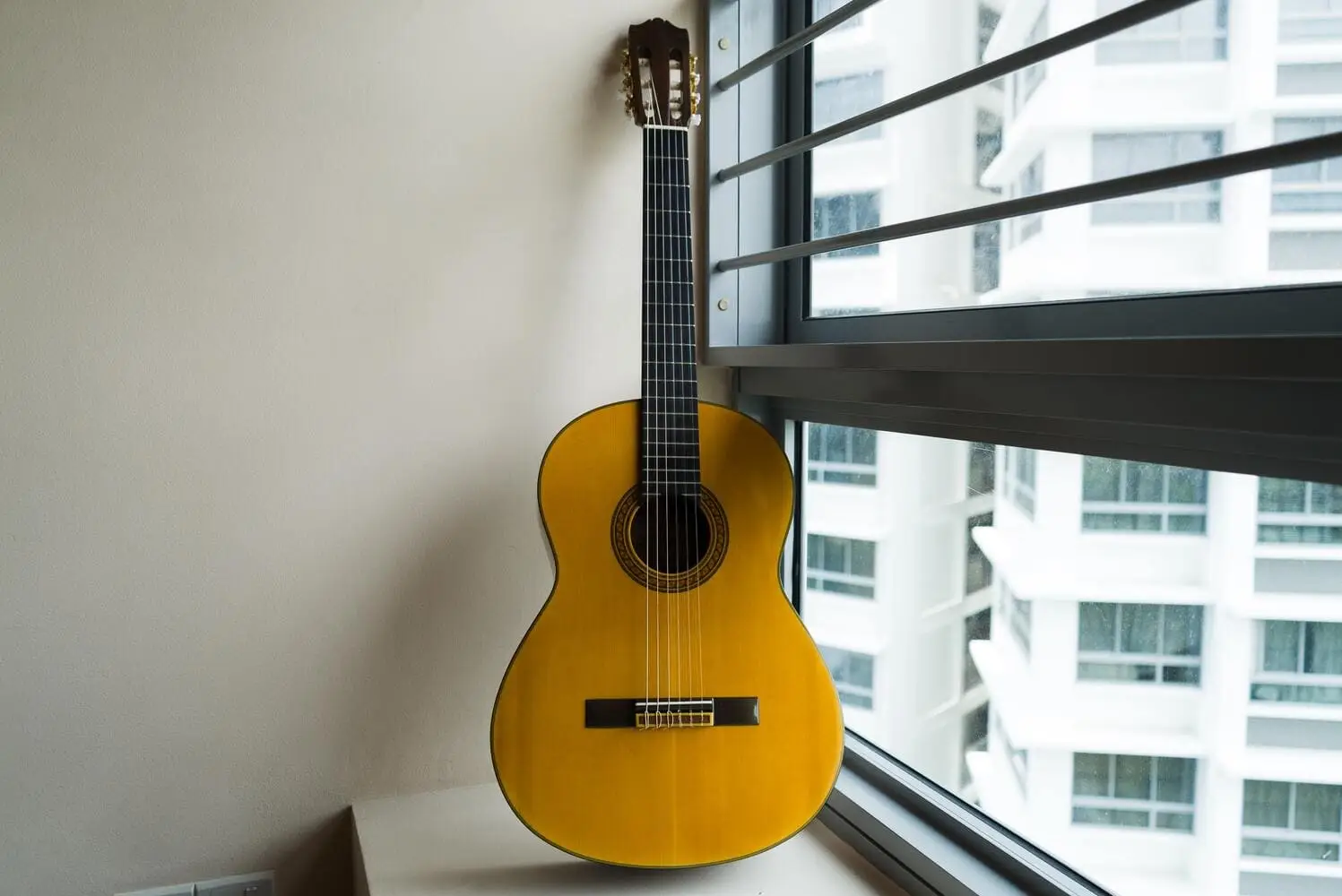Are you looking for the best flamenco guitar lessons? Here is a list of the 10 best songs to learn to play flamenco guitar in English. I hope you enjoy the selection.
- «Entre dos aguas» – Paco de Lucia
«Entre dos aguas» is indeed a timeless masterpiece by the legendary flamenco guitarist Paco de Lucía. Released in 1973, it quickly became one of his most iconic compositions, showcasing his virtuosity and innovation within the flamenco genre.
The title «Entre dos aguas» translates to «Between Two Waters,» which metaphorically refers to the blending of traditional flamenco music with more contemporary styles, such as jazz and Latin rhythms. This fusion of influences is evident throughout the song, making it both accessible to beginners and captivating for seasoned musicians.
One of the defining features of «Entre dos aguas» is its intricate rhythm and strumming technique. Paco de Lucía’s mastery of flamenco guitar techniques, including rasgueado (rapid strumming with the fingers) and golpe (percussive tapping on the guitar body), is on full display in this piece. The rhythm alternates between the upbeat bulerías and the slower, more contemplative soleá, creating a dynamic contrast that keeps the listener engaged.
For aspiring flamenco guitarists, learning to play «Entre dos aguas» provides a valuable foundation in both technique and style. It requires precision in both the right-hand strumming patterns and the left-hand fretwork, challenging players to develop speed, agility, and expression. Additionally, studying this piece allows guitarists to explore the rich tradition of flamenco music while also embracing innovation and experimentation.
Overall, «Entre dos aguas» remains a timeless gem in the world of flamenco guitar, embodying Paco de Lucía’s revolutionary approach to the genre and serving as an inspiration for generations of musicians to come.
Paco de Lucía’s «Entre dos aguas» has enjoyed continuous popularity since its release in 1973. Its enduring appeal lies in its unique blend of traditional flamenco with contemporary influences, making it a timeless masterpiece that transcends generations and musical boundaries.
Over the years, «Entre dos aguas» has become a staple in the repertoire of flamenco guitarists worldwide, serving as a benchmark for technical proficiency and artistic expression. Its intricate rhythms, mesmerizing melodies, and masterful guitar techniques continue to captivate audiences and inspire musicians of all levels.
The song’s influence extends beyond the flamenco community, reaching listeners across diverse musical genres. Its fusion of flamenco with elements of jazz, Latin, and world music has garnered widespread acclaim, earning it recognition as one of the most innovative compositions in the history of Spanish guitar.
«Entre dos aguas» has also left a lasting legacy in popular culture, appearing in films, television shows, and commercials, further solidifying its status as a cultural icon. Its timeless appeal has led to numerous reinterpretations and covers by artists from various musical backgrounds, ensuring its relevance in contemporary music.
As a result, «Entre dos aguas» remains a symbol of Paco de Lucía’s unparalleled talent and visionary approach to flamenco guitar, continuing to inspire and influence musicians around the globe, ensuring its place as a classic for years to come.
2. «Recuerdos de la Alhambra» – Francisco Tárrega
«Recuerdos de la Alhambra» is indeed a masterpiece for classical guitar composed by the renowned Spanish guitarist and composer Francisco Tárrega. While not a flamenco piece in its style or origin, it holds significant value for guitarists, including those interested in flamenco, due to its technical demands and musical beauty.
Composed in 1896, «Recuerdos de la Alhambra» translates to «Memories of the Alhambra,» referencing the stunning Moorish palace in Granada, Spain. The piece evokes the ambiance of this historic site through its intricate arpeggios, delicate melodies, and evocative harmonies.
One of the key aspects that make «Recuerdos de la Alhambra» relevant to flamenco guitarists is its emphasis on arpeggios and fingerstyle techniques. Tárrega’s use of rapid arpeggios, where the notes of a chord are played individually rather than simultaneously, challenges the guitarist’s finger dexterity, control, and precision—skills that are also essential in flamenco guitar playing.
Furthermore, the piece incorporates techniques such as tremolo, where a rapid alternation of notes is played on a single string, creating a shimmering effect. Tremolo is a technique commonly utilized in flamenco guitar to evoke emotion and intensity, making «Recuerdos de la Alhambra» a valuable study for mastering this technique.
Moreover, the expressive nature of «Recuerdos de la Alhambra» encourages guitarists to focus on dynamics, phrasing, and interpretation—elements that are equally important in flamenco music for conveying passion and emotion.
While «Recuerdos de la Alhambra» may not adhere strictly to the flamenco tradition, its technical challenges and musical depth make it an excellent choice for guitarists seeking to enhance their skills, including those aspiring to delve into flamenco guitar playing. By mastering this piece, guitarists can develop the finger strength, agility, and musical sensitivity necessary to excel in various styles, including flamenco.
Additionally, «Recuerdos de la Alhambra» holds a special place in the repertoire of classical guitarists worldwide, admired for its beauty and technical complexity. Its haunting melody and intricate arpeggios have captivated audiences for over a century, making it one of Tárrega’s most beloved compositions.
Studying «Recuerdos de la Alhambra» provides guitarists with a comprehensive workout for both the right and left hands. The demanding fingerstyle techniques required to execute the piece effectively, such as precise finger placement, independent finger movement, and control over dynamics, translate well to the demands of flamenco guitar playing.
Moreover, the piece offers valuable insights into musical phrasing, expression, and interpretation, skills that are essential for conveying the emotion and intensity inherent in flamenco music. By mastering the nuances of «Recuerdos de la Alhambra,» guitarists can deepen their understanding of musicality and refine their performance skills, laying a solid foundation for exploring the rich tradition of flamenco guitar.
In summary, while «Recuerdos de la Alhambra» may not be a flamenco composition per se, its technical challenges and musical depth make it an invaluable resource for guitarists aspiring to improve their skills, particularly in the realm of flamenco guitar. By studying and mastering this timeless masterpiece, guitarists can unlock new levels of proficiency and artistry, enriching their musical journey and broadening their repertoire.
3. «Malagueña» – Ernesto Lecuona
«Malagueña» is indeed a timeless classic within the realm of flamenco guitar music, composed by the Cuban composer Ernesto Lecuona. While not strictly a flamenco song in its origin, it has been adopted and adapted within the flamenco repertoire due to its evocative melodies, rhythmic complexity, and technical demands, making it a staple piece for flamenco guitarists.
One of the defining characteristics of «Malagueña» is its intricate blend of arpeggio and strumming techniques, which showcase the versatility and virtuosity of the flamenco guitar. The piece typically incorporates rapid arpeggios—where individual notes of a chord are played in succession—alongside percussive strumming patterns, creating a dynamic and captivating sonic landscape.
The fusion of arpeggios and strumming in «Malagueña» reflects the multifaceted nature of flamenco guitar playing, where performers must master a diverse range of techniques to convey the depth and emotion of the music. By combining delicate fingerwork with powerful rhythmic accents, guitarists can evoke the passionate spirit of flamenco while highlighting the intricate beauty of Lecuona’s composition.
Furthermore, «Malagueña» is known for its rich harmonic palette and melodic embellishments, which provide ample opportunities for expression and interpretation. The piece’s modal chord progressions and syncopated rhythms draw upon the traditions of Spanish and Latin American music, reflecting Lecuona’s diverse musical influences and contributing to its universal appeal.
As a result, «Malagueña» has been interpreted and performed in a variety of styles, ranging from traditional flamenco to jazz, classical, and beyond. Its enduring popularity speaks to its status as a timeless masterpiece, cherished by guitarists and audiences alike for its beauty, complexity, and emotional depth.
In summary, «Malagueña» holds a special place in the flamenco guitar repertoire, exemplifying the genre’s fusion of technical prowess, expressive lyricism, and cultural richness. Its combination of arpeggio and strumming techniques, along with its evocative melodies and rhythmic intricacies, make it an essential piece for flamenco guitarists seeking to hone their skills and explore the depth of the flamenco tradition.
4. «Asturias (Legend)» – Isaac Albéniz
«Asturias (Leyenda)» is indeed a celebrated classical guitar composition written by the Spanish composer Isaac Albéniz. Composed as part of his suite «Suite española, Op. 47,» it was originally written for piano but has since been transcribed for guitar, where it has become one of the most iconic pieces in the classical guitar repertoire.
Despite not being a flamenco piece, «Asturias (Leyenda)» holds significant relevance for flamenco guitarists due to its demanding finger techniques and virtuosic passages. The piece is known for its rapid and intricate sequences of notes, requiring precision, speed, and control from the guitarist.
One of the key technical challenges presented in «Asturias (Leyenda)» is its use of tremolo—a technique where a rapid alternation of notes is played on a single string while maintaining a melody. Tremolo is a fundamental technique in flamenco guitar playing, used to create a sense of intensity, passion, and drama. By mastering the tremolo passages in «Asturias (Leyenda),» guitarists can develop the finger strength, agility, and coordination necessary for performing flamenco compositions effectively.
Furthermore, «Asturias (Leyenda)» features intricate arpeggios, complex chord progressions, and rapid scale runs, all of which contribute to its technical demands. These elements mirror some of the challenges encountered in flamenco guitar playing, where agility, precision, and control are essential for executing intricate passages with flair and expressiveness.
Moreover, the evocative nature of «Asturias (Leyenda)»—with its haunting melodies and dramatic shifts in dynamics—provides guitarists with an opportunity to explore phrasing, expression, and interpretation, skills that are equally vital in flamenco music for conveying emotion and storytelling.
In summary, while «Asturias (Leyenda)» may not be rooted in flamenco tradition, its technical complexity and expressive qualities make it a valuable piece for flamenco guitarists seeking to enhance their skills and broaden their repertoire. By studying and mastering this timeless composition, guitarists can refine their technique, deepen their musical understanding, and enrich their performance abilities, ultimately contributing to their development as versatile and accomplished musicians.
5. «Rumba» – Juan Serrano —one of the best flamenco guitar lessons
«Rumba» is a vibrant and rhythmic flamenco style characterized by its lively tempo, infectious groove, and intricate strumming patterns. While it’s a genre rather than a specific song, «Rumba» has been popularized by numerous flamenco guitarists, including Juan Serrano, who has contributed significantly to its development and popularization.
One distinctive feature of the «Rumba» style is its energetic and percussive strumming technique, known as «rasgueo al golpe» or «golpe rasgueado.» This technique involves striking the strings with the fingers while simultaneously tapping the guitar body, producing a sharp percussive sound. The golpe rasgueado adds depth and rhythm to the music, creating a driving pulse that propels the piece forward.
Juan Serrano’s contributions to the «Rumba» style showcase his mastery of flamenco guitar technique, particularly in his adept use of rasgueo al golpe. His compositions and performances often highlight the dynamic interplay between intricate melodic lines and percussive strumming patterns, creating a captivating and immersive listening experience.
For aspiring flamenco guitarists, studying «Rumba» provides an excellent opportunity to develop essential techniques and skills inherent in flamenco music, including rasgueo al golpe. Mastering this technique requires precision, speed, and control, as well as a deep understanding of rhythm and timing—all of which are fundamental to the flamenco tradition.
Moreover, «Rumba» serves as a testament to the rich cultural heritage and expressive potential of flamenco music. Its infectious rhythms and vibrant melodies evoke the spirit of Andalusia, the birthplace of flamenco, and celebrate the joyous and festive aspects of the flamenco tradition.
In summary, «Rumba» stands as a quintessential example of flamenco music, showcasing the genre’s signature rhythms, melodies, and techniques. Juan Serrano’s contributions to the «Rumba» style, particularly his mastery of rasgueo al golpe, highlight the technical complexity and artistic depth of flamenco guitar playing, making it an essential piece for aspiring flamenco guitarists to study and appreciate.
6. «Zorongo Gitano» – Federico García Lorca
«Zorongo Gitano» is a poignant and evocative flamenco song, with lyrics penned by the renowned Spanish poet Federico García Lorca. It is a testament to Lorca’s deep connection to Andalusian culture and his ability to capture the essence of flamenco in his poetry. The song’s emotional depth, combined with its intricate melodies and rhythmic complexity, has made it a cherished piece within the flamenco tradition.
One of the distinctive features of «Zorongo Gitano» is its unique strumming technique, which is integral to flamenco guitar playing. While the specific strumming pattern can vary depending on the interpretation, the song typically incorporates a combination of rasgueado (rapid strumming with the fingers) and golpe (percussive tapping on the guitar body). These techniques add texture and rhythm to the music, enhancing its emotional impact and capturing the essence of flamenco’s expressive power.
As with many of Lorca’s works, «Zorongo Gitano» is renowned for its poignant lyrics and melancholic melodies. The song explores themes of love, longing, and loss, reflecting the deep emotional currents that run through flamenco music. Lorca’s imagery-rich poetry paints a vivid picture of Andalusian life and culture, transporting listeners to a world of passion and intensity.
For flamenco guitarists, «Zorongo Gitano» offers a rich tapestry of musical and emotional expression to explore. Mastering the strumming technique and interpreting the song’s nuanced melodies require technical skill, sensitivity, and an understanding of flamenco’s rhythmic intricacies. Moreover, engaging with Lorca’s poetry adds an additional layer of depth and meaning to the music, inviting performers to embody the song’s emotional landscape through their playing.
In summary, «Zorongo Gitano» stands as a quintessential example of flamenco music, blending Federico García Lorca’s lyrical poetry with the expressive power of flamenco guitar. Its unique strumming technique, emotional lyrics, and melancholic melodies make it a beloved piece within the flamenco tradition, inviting performers and listeners alike to immerse themselves in its rich tapestry of sound and emotion.
7. «Bulerías» – Paco Peña
«Bulerías» is a flamenco song written by the Spanish guitarist Paco Peña. It is a song that features a complex and fast strumming technique that is important for flamenco guitarists. The song is an excellent example of the complicated and passionate rhythmic playing that is characteristic of flamenco music.
8. «Sevillanas» – Traditional
«Sevillanas» is a traditional song from the Seville region of Spain. It is a song that is commonly performed at fairs and festivals. The song features a unique strumming and rhythmic technique that is important for flamenco guitarists. Learning to play «Sevillanas» is an excellent way to improve strumming technique and understanding of rhythm in flamenco music.
9. «La Malagueña» – Elpidio Ramírez
«La Malagueña» is a traditional Mexican song that has been adapted into flamenco music. The song features a strumming technique and a rhythm that is important for flamenco guitarists. The song is known for its melody and emotional lyrics.
10 «Soleá» – Paco de Lucía
«Soleá» is a flamenco song written by Paco de Lucía. It is a song that features a complex strumming and arpeggio technique that is important for flamenco guitarists. The song is an excellent example of the slow, emotional rhythmic playing that is characteristic of flamenco music.
In short, the flamenco guitar is one of the most fascinating and complex art forms in the world. Learning to play this instrument requires a lot of practice and dedication, but with the right choice of songs, anyone can begin to master the unique technique and style of flamenco music.
The 10 songs listed above are an excellent selection for those looking to improve their flamenco guitar skills. From classical pieces to popular songs, these songs present a variety of techniques and styles that are important for flamenco guitarists.
Remember that, in addition to learning the songs, it is also important to practice flamenco guitar technique. Make sure you spend time practising strumming, arpeggio and finger techniques, and never give up. With time and dedication, anyone can learn to play flamenco guitar like a true master. Good luck!



